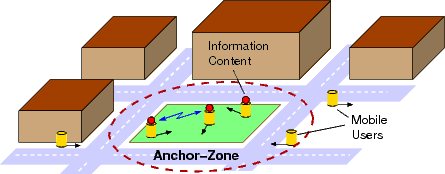Floating Content
(Joint work with Prof. J. Ott, Prof. J. Kangasharju, Dr. P. Lassila and Prof. J. Virtamo)
Floating Content, proposed by Kangasharju et al. in [6], is a best effort, geographically limited information dissemination scheme using principles of opportunistic networking. In Floating Content, a message (a text message, an image, etc.) deemed to be of interest to other people at a certain area is tagged with geographical coordinates of that area. This area is referred to as the anchor-zone of the message. A message is disseminated in opportunistic manner whenever two nodes meet within the anchor-zone. Outside the anchor-zone, nodes are free to delete it. The unique characteristics are that the scheme does not rely on any infrastructure (cf. privacy aspects), a message can only be created and distributed locally, and it cannot be deleted afterwards. Instead, a message remains available within the anchor-zone until it expires, assuming there is a sufficient number of nodes in the anchor-zone constantly to ensure that the message does not disappear accidentally. However, due to stochastic fluctuations, there is a finite probability that the message gets deleted before the expiration time.
Our WorkThe research question we have studied is under what circumstances a message remains available. This involves.
|

Figure: Floating Content, a localized opportunistic information dissemination scheme. |
References
See the floating content in action (a simple java applet).

